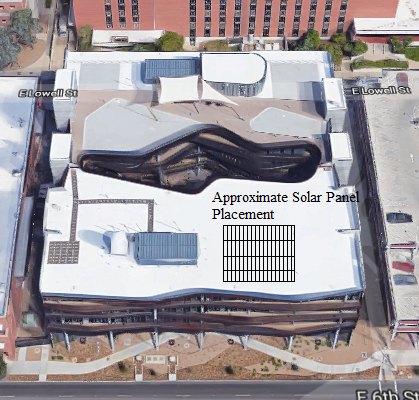A project to get solar panels placed on top of the Environment and Natural Resources 2 building at the University of Arizona is underway with support from Students for Sustainability and many other UA programs, groups and departments. As of Jan. 30, the project is only in the proposal phase.
Stanley Wong is a UA student and the chair of the Energy and Climate Committee for Students for Sustainability. He is one of the leaders behind this project.
“Including installation and student workers, the total cost for this project over three years is $132,000, rounded up,” Wong said. “We wrote a Green Fund grant proposal, and we hope most of the funding will come from Green Fund.”
RELATED: ‘Sustainable Built Environments’ lecture series leads off with UA’s Champion
The UA Green Fund is a student-funded grant program for funding sustainability projects that distributes $400,000 per year to these projects. These grants are available for any member of the UA community, from undergraduates to faculty.
The actual logistics of the project are another story.
“The project management funding will come from Facilities Management and Planning, Design and Construction,” Wong said.
The UA could recoup a portion of the investment in savings, in addition to the environmental impact of the project.
After installation, the solar panels could “eliminate 2.3 million pounds of carbon emissions and save [the UA] about $101,388 over 20 years,” Wong said. “If the Green Fund gets approved, the solar panels should be up and open by November 2018. And hopefully we can put solar panels on other buildings.… That’s definitely a long-term goal.”
Wong said this project is not simply about solar panels:
“This project is a little bit of an experiment as well, because we’re also putting a garden underneath the panels. The solar panels will provide shade for the garden,” Wong said.
The UA Community and School Garden Program will be handling the garden under the solar panels, according to Wong.
Plants being grown under solar panels can benefit both the plants and the solar panel. “Most of the food crops we grow here are exotic and haven’t adapted to our climate like our native plants have,” said Moses Thompson, UA and TUSD school gardening coordinator. “Growing under the panels seems a little more comfortable for a number of food crops. Also the evaporation from the irrigation and transpiration from the plants has a cooling effect on the panels, which bumps up efficiency.”
Dr. Greg Barron-Gafford, UA associate professor and associate director, specified the types of plants in-store for the garden:
“We are planning to plant a range of vegetable species in sets of 300-gallon containers,” Barron-Gafford said.
RELATED: UA makes sustainability competitive
Other solar panel gardens, better known as agrivoltaic gardens, already exist throughout the Tucson area, including installations at Biosphere 2, Manzo Elementary and at Rincon University High School, according to Barron-Gafford. However, this will be the first rooftop installation.
Both Thompson and Barron-Gafford are involved in the proposal.
Many UA groups came together to make this project happen. “We’ve worked with Facilities Management, the Office of Sustainability, Planning, Design and Construction, the Institute of the Environment, the UA’s Garden Community Program, SolarCats and Students For Sustainability,” Wong said.
The UA has been supporting solar power usage throughout campus and around Tucson. The UA Tech Park houses a solar farm, and the bike share program, Tugo, which is installed around campus, uses solar-powered docks.
Follow the Daily Wildcat on Twitter









